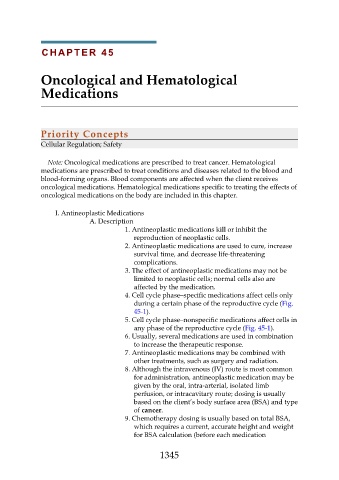Page 1345 - Saunders Comprehensive Review For NCLEX-RN
P. 1345
CHAPTER 45
Oncological and Hematological
Medications
Priority Concepts
Cellular Regulation; Safety
Note: Oncological medications are prescribed to treat cancer. Hematological
medications are prescribed to treat conditions and diseases related to the blood and
blood-forming organs. Blood components are affected when the client receives
oncological medications. Hematological medications specific to treating the effects of
oncological medications on the body are included in this chapter.
I. Antineoplastic Medications
A. Description
1. Antineoplastic medications kill or inhibit the
reproduction of neoplastic cells.
2. Antineoplastic medications are used to cure, increase
survival time, and decrease life-threatening
complications.
3. The effect of antineoplastic medications may not be
limited to neoplastic cells; normal cells also are
affected by the medication.
4. Cell cycle phase–specific medications affect cells only
during a certain phase of the reproductive cycle (Fig.
45-1).
5. Cell cycle phase–nonspecific medications affect cells in
any phase of the reproductive cycle (Fig. 45-1).
6. Usually, several medications are used in combination
to increase the therapeutic response.
7. Antineoplastic medications may be combined with
other treatments, such as surgery and radiation.
8. Although the intravenous (IV) route is most common
for administration, antineoplastic medication may be
given by the oral, intra-arterial, isolated limb
perfusion, or intracavitary route; dosing is usually
based on the client’s body surface area (BSA) and type
of cancer.
9. Chemotherapy dosing is usually based on total BSA,
which requires a current, accurate height and weight
for BSA calculation (before each medication
1345

